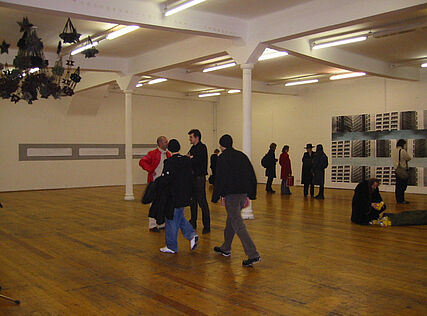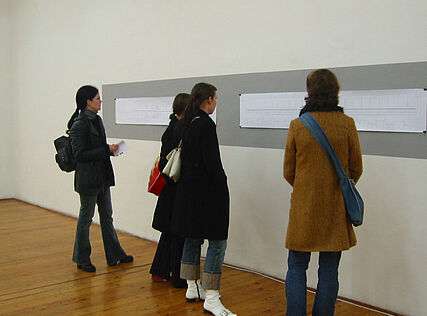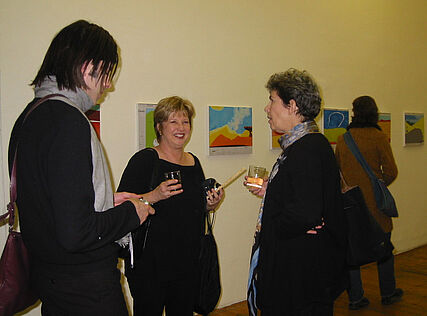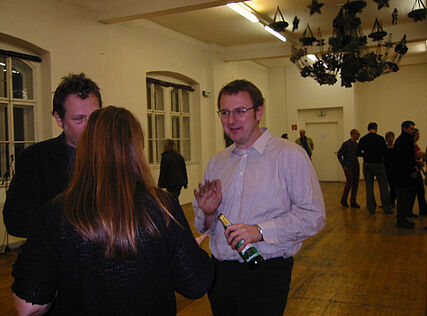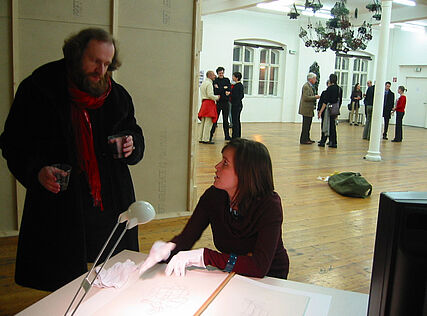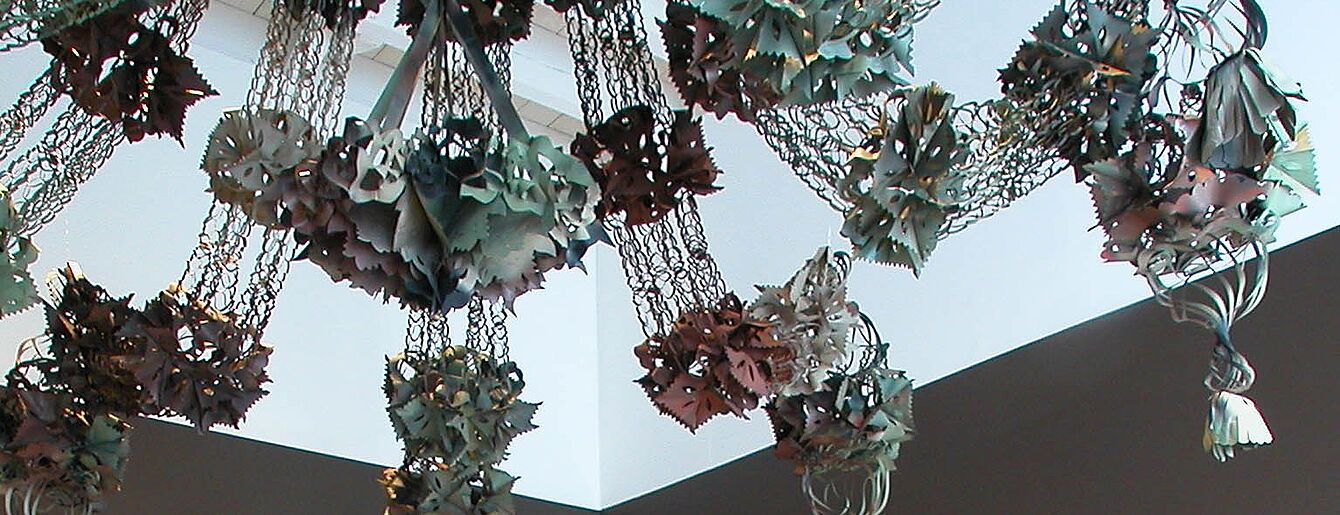
We 10.11.2004 - Fr 10.12.2004
Kunsthalle Exnergasse
AMERICAN VISIONS AND REVISIONS
Reception: 10.11. 2004, 7 p.m.
curated by: Erin Donnelly and Susanna Cole
Artists: Ayreen Anastas, Jane Benson, Rene Gabri, Benj Gerdes, Alina Viola Grumiller, Alia Hasan-Khan, Marc Lepson, Pia Lindman, Oliver Ressler, Nida Sinnokrot, Karina Aguilera Skvirsky, David Thorne
Over the past three years, artists have provided timely and significant insight into the foreign policy of the United States, into the portrayal of that policy in the media and into the formative influence of the media in the production of opinion about global events. These artists critique the various media in order to penetrate the façade created by popular communication forms such as film, television, print and electronic media to make visible the fabricated nature of its authority.
Performances: 11.11. 2004, 12 p.m. & 5 p.m. "New York Times Performance Tour in Vienna"
Pia Lindman will take you on a one hour tour to select monuments in Vienna and perform next to each of them. The tour starts at Kunsthalle Exnergasse
Over the past three years, artists working in the United States, both citizens and non-citizens, have provided timely and significant insight into the foreign policy of the United States, into the portrayal of that policy in the media and into the formative influence of the media in the production of opinion about global events. These artists critique the various media such as film, video, print and electronic media in order to penetrate the façade they create and to make visible the fabricated nature of its authority.
It is a commonplace to credit the information age with narrowing the gap between divergent cultural viewpoints. In fact, however, there remain among nations and cultures profoundly felt distances and differences of perception and experience, distances and differences in part both created by and perpetuated by a narrow, self-censoring and privileged group of Americans in corporate and government life. This recent body of work by contemporary artists recognizes the role of mainstream images in forming and hardening the American armor of isolationism and faux-patriotism, of self versus other. It also proposes to establish dialectical relationships out of which new understandings of national policy and global realties can be generated.
Appropriately, some of the art works to reappropriate visual language from the dominant media and to give new vision and new focus to the mind’s eye of the viewing public. Nida Sinnokrot’s Untitled Shutter, 2002, reiterates the way in which 19th century Europe used the photographic image to project its desires and fears onto the Orient. The project of colonization by means of the imaging and stealing of the souls of its subjects is rehearsed for the gallery audience with the snap of a shutter. Karina Aguilera Skvirsky A Nation Challenged, 2003, takes its title from the special section of The New York Times that appeared in the year after 9-11-2001 and that covered those that died in the attack and the variety of issues that arose in the aftermath of the attack, including sentimentalized and self-serving articles about the Afghani people. Using Photoshop, Skvirsky took photographs from The New York Times of Afghans and placed them in cartoon scenery of the American West accompanied by the photographic captions that she manipulated in order to bring forward certain parts of the text. Her images make those of The New York Times at once less sentimental, less alien and also more clearly fictive. Pia Lindman’s New York Times, 2004, is an exposé of the body language of mourning. Lindman takes as her starting point photographs that were published so prolifically in The NY Times between September 2002 and September 2003 of people grieving in the aftermath of terrorist acts. With a serenity and decorousness that stands in contrast to the fevered aura of the photographs, Lindman strips bare these images enshrouded in cultural sentiment and casts a cold eye on the gestures we use to express grief. Unsparingly unsentimental, New York Times is also finally and emphatically hopeful as it makes its way through heightened self-consciousness towards an expression of the unselfconscious and elemental.
The operations of the Office of Homeland Security and the secret security forces unleashed by the US Patriot Act are made visible in Marc Lepson’s, Metropolitan Detention Center, Brooklyn, NY (Breathe), 2002. Lepson’s work revises the media representation of the thousands of Arabs, south Asian and Muslim immigrants who have been arbitrarily and secretly detained since 9 11. Disarming the authority of the prison façade behind which the detainees have been held, screen-printed patterns shift in perspective to flatten the building’s depth while traditional Islamic textile and tile designs are evoked in the repetition of structural details on its surface. In contrast to the narratives in the media, Lepson’s work registers an alternative experience of the silenced. Finally, Breathe raises important questions about the civil space of all Americans. In the fall of 2002, Rene Gabri and Ayreen Anastas created a fictitious website, http://www.hscb.org/, for the fictitious Homeland Security Cultural Bureau which claimed responsibility for shutting down 16beavergroup. This hoax and the reaction that ensued in now documented online athttp://www.16beavergroup.org/radioactive/. In My Wife’s Visa and Babies, 2004, Gabri and Anastas give us two of the responses to that website, one seeking help in circumventing some of the more convoluted security and immigration regulations in the U.S. and the other from a paranoid attempting to enlist their aid against an invasion of alien babies. These two authentic voices give us the opportunity to reflect on the forces that such an institution, however fictive or real, puts into play.
The transformation and deflation of the heroism, generosity and beauty of war is not a new topic but is dealt with here in new and visually striking ways. Gift, 2002, by Alia Hasan-Khan captures the ironies of U.S. humanitarian work in Afghanistan. Gift incorporates objects modeled after the food packages dropped into Afghanistan by the U.S. in October, 2001, packages that were the same color as the yellow cluster bombs that were being dropped by U.S. military planes. The packages included peanut butter and jelly, bean salad, a fruit bar, shortbread: all food items unfamiliar to the Afghans. Accompanying the packages were instructions on how to eat the food, instructions written in English, French and Spanish – none of which are spoken in Afghanistan. Subsequent radio broadcasts described the difference between the rectangular food packages and the cluster bombs and pictures included in the packages illustrated how to eat the food. In Jane Benson’s, Underbush, 2004, garlands of foil festoon the ceiling of the gallery. Benson morphs their celebratory meaning by painting over the flashy foil colors with the matte palette of camouflage. Beneath this beautiful and ominous chandelier hangs a related work, a deconstructed camouflage jumpsuit emptied of its auratic power. Benson’s images expose the deceitful and hollow self-aggrandizement of those who play military dress-up amid the glittering spectacle of war.
To some degree, the reimagining of the possibility of protest must be at the heart of every oppositional work of art. Benj Gerdes and Alina Viola Grumiller’s On the Passage of Millions of People through a not brief enough Period of Time, 2004, is a 30 minute collaborative video essay that uses footage and interviews shot during the Republican National Convention in New York City in August, 2004, to discuss the relationship of architecture and the human body in contemporary mass protest. Gerdes and Grumiller query the possibility of creating significant protest in a large, stimulating city such as New York, a city saturated with events and people in which traditional forms of protest are lost in an urban environment simultaneously privatized and immensely public. In paying attention to the interstitial architectural spaces between streets and buildings and the human spaces between people, Gerdes and Grumiller locate powerful new methodologies of protest and of the documentation of protest. Oliver Ressler and David Thorne’s Three Proposals for Banners, 2004, is part of their larger collective project, Boom. The first proposal consisted of three banners, each heralding a different disfunctional URL for a website with a political message. This, the second proposal, creates new architectural spaces for those new urls, spaces atypical of the traditional didactic rhetoric of oppositional politics.
At this moment, even more so now than we could have imagined when we first proposed this show in 2002, the government of the U.S. shows an unprecedented disregard for human rights both domestically and internationally, a disregard abhorred by half the nation’s population and much of the rest of the world. We are grateful that these artists are neither silent nor blind. Among the rising voices of opposition, their work envisions the means to new visions.
Susanna Cole

